Duccio Controversy at the Met
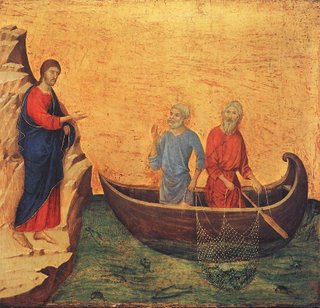
I'm a fan of many of the things attributed to Duccio -- especially the little scenes, like the one above (from the National Gallery) that just seem saturated with the mystery and drama of faith (Jesus catching Peter, like Andrew catching fish -- while all three are floating -- either on air or water)
And -- as readers may have noticed -- I'm not a fan of museum management as we now know it -- so when my copy of "Bible Archeology Review" alerted me to this controversy -- I just had to check it out.
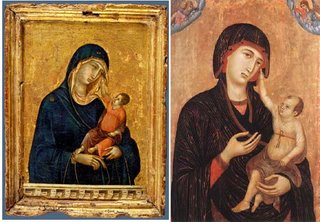
Basically -- this is a controversy between one man, James Beck (Professor of art history at Columbia Univ. and founder of a group called "ArtWatch Intl.") and the Metropolitan Museum of Art that just spent $40 million for the painting shown on the left. (the Madonna to the right is called the "Crevole Madonna")
Professor complains about the “low quality” of the Met’s painting — the Child’s raised arm and hand, “which appears like a stump”, and its “gourd-like head, which is quite at odds with confirmed and documented paintings by Duccio” -- "“We are asked to believe that the modest little picture represents a leap into the future of Western painting by establishing a plane in front of Mary and the Child. This feature, a characteristic of Renaissance not Medieval pictures, occurs only a hundred years after the presumptive date of the picture"..“Devastating to the Met’s claims is the fact that no other examples with the combination of elements — Madonna and Child with a space-defining parapet — are found among the confirmed works by Duccio or his followers, or in all of Tuscany, for that matter.”... “The artist or forger must have worked up this idea from hindsight rather than foresight.”
On the other hand.... the Met's website says:
"So profound is the change that animates Duccio’s art during these years," said Mr. Christiansen, "that art historians understandably presume an external stimulus. This must have been a trip to Assisi, where Duccio studied the recently completed fresco cycle of the life of Saint Francis by Giotto and a large équippe of assistants. It has now been demonstrated that this celebrated fresco cycle was completed prior to 1295–96. What impressed Duccio were the illusionistic devices Giotto introduced to frame the individual scenes as well as his ability to create a cogent, pictorial space inhabited by figures possessing weight and density. It was an art that embraced the complex and varied world of human experience, rather than one based on codified types, as had been the case with medieval and Byzantine painting. Duccio responded by exploring in his own art this new world of sentiment and emotional response, but with a lyricism and sensitivity to color that became the basis of Sienese painting. This new, complex vision attains its first clear statement in the Metropolitan Madonna and Child, and it is for this reason that this small panel intended for private devotion is so revolutionary."
In his 1979 monograph on Duccio, British scholar John White characterized the Metropolitan painting as "the first, lonely forerunner of that long line of Italian Madonnas with a parapet which achieved its finest flowering almost two centuries later in Giovanni Bellini’s splendid variations on the theme."
... all prefaced with the claim that:
" Among the great single acquisitions of the last half century and a work of sublime beauty, the addition of the Duccio to the Museum’s collection enables visitors to follow the entire trajectory of European painting from its beginnings to the present.
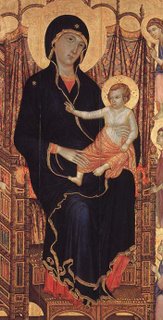
Here's my favorite of the Madonnas attributed to Duccio (called the "Rucellai") -- and others follow:
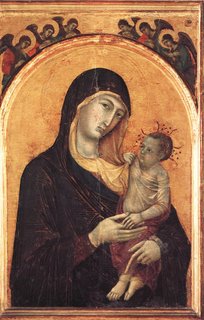
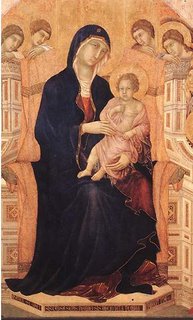 (This one is a detail from the "Maesta" -- Duccio's last and most famous work)
(This one is a detail from the "Maesta" -- Duccio's last and most famous work)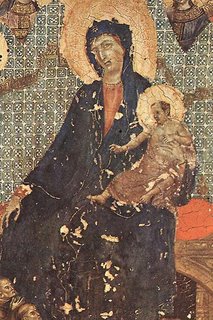 (This one from a Franciscan monastery)
(This one from a Franciscan monastery)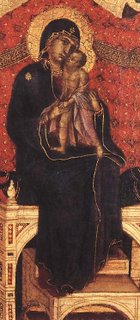 (This one from a museum in Bern)
(This one from a museum in Bern)So...there's quite a variety of paintings here that have been attributed to Duccio -- and frankly, some of them seem to me to have been designed by different people.
But among all of them -- the new one at the Met does stand out as being the worst -- it feels sad and pathetic beside these other examples that seem to be bubbling out with internal life. It's profiles are weak -- and the "stump" feels like a injured stump -- where a similar arm -- in the Crevole Madonna -- does not.
I don't know much about James Beck -- but anyone who has noticed how many museum paintings have been destroyed by over-enthusiastic "restoration" has to admire the mission of his "Artwatch Intl." -- and I can't wait to read his new book about the "Crisis in Connoisseurship".
I don't really care whether this painting is called a Duccio or not -- the real issue, for me, is what are its spiritual-aesthetic qualities -- and this one appears to be a clunker.
My issues with the Met are as follows:
1. I think that when museums use their own funds to acquire things - they should buy against -- rather than with -- trends of value. The time to buy good , early Italian painting was 100 years ago -- the time to buy Chinese painting was 60 years ago -- the time to buy Academic French painting was 20 years ago -- and the time to buy 20th C. figure sculpture is --- now.
2. If the Met takes its educational role seriously -- it should explain -- in detail -- why they're attributing their new Madonna to the same artist who made Sienna's "Maesta" -- and not just brush off James Beck because he's not a recognized expert in Duccio. (after all -- he is a published scholar on Italian Renaissance painting and sculpture). As I understand it, the provenance of this piece does not go back more than 100 years -- and, of course, it's not signed. So what are the good reasons to call it a 'Duccio" ?
3. And if the Met takes its educational role seriously --- it should provide a nice, big, high-resolution scan of this painting on its website. (since the piece is covered with reflective glass when it's on public display -- only the Met can take such a picture)


6 Comments:
After thinking awhile about how to express the feelings of timelessness in these Duccio paintings I came across this:
"What I dream about is an art of equilibrium, purity, and tranquillity, without disquieting or disturbing subjects..." --Henri Matisse(1908)
Museums, alas, as buyers, by and large, run with the heard. And there has been a real shortage of good quality art recently, so expect more lousy crap purchases explained by "educational value" (or some such drivel). Could not agree with you more regarding the high quality scans. Why do most museums guard their reproduction rights so jealously? (The National Galley must be the worst offenders: i cant bear to look at their stuff imprinted with three dimentional "Natioanl Gallery" logos which occupy half the surface of the paintings). Do they REALLY make so much money from reproduction rights? And, indeed, should they be allowed to?
It's funny how things play out:- Regolo offers a quote from Matisse that could have come from the next person to comment, Gawain. (although I doubt Gawain would find " equilibrium, purity, and tranquillity" in the paintings of Matisse.)
And I often long for that kind of thing too ( although I can also like turbulence and impurity -- like, say, some fighting animals by Barye ?)
One thing about this early Italian style -- with its strong, simple shapes, linearity, and shallow picture space: it reproduces very well on the internet - all the more reason for museums to maximize their internet presentation -- instead of trying to maximize income -- which I suspect is uppermost in the mind-set of American museum leadership -- right up there beside educating the un-washed public on
"the trajectory of European painting"
The internet discussion we're now having -- by rather sophisticated art lovers -- concerning a museum's new acquisition -- is exactly the kind of thing that a museum should want to encourage and enable -- with the best scans -- and commentary -- that they can offer.
But instead -- we get a miserable scan -- and brief commentary that's more like the 30-second advertising copy for a jewelry shop.
Befriend collectors...the most direct route to sales sans disgusting commission and also the avenue to the best viewings, unimpeded by commercialism.
About art scans: Europeans are even worse. At least SOME Americans give you half-decent scans. Europeans give you postage-stamps things, if anything, usually embossed with "copyright". What COPYRIGHT, I ask you? Matisse? Who's Matisse? btw look at my place for a really nice early italian style. i keep going back to look at my own blog -- just to see it again.
I finally had the time to read this post properly...and ugh, that thing on the left is grotesque. I enjoyed that you showed a damaged one...I am ever interested in anything fragmented like this that you might choose to show. It isn't the strongest image among the grouping, but those wounds of time, etc. do lend a power to the piece that one is hard-pressed to find in even the most polished, perfect icon.
Lovely and lively reading, as ever.
Post a Comment
<< Home